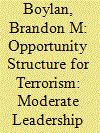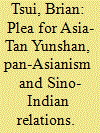|
|
|
Sort Order |
|
|
|
Items / Page
|
|
|
|
|
|
|
| Srl | Item |
| 1 |
ID:
165694


|
|
|
|
|
| Summary/Abstract |
Why does terrorist violence escalate from some ethnic groups but not others? According to theoretical insights, many groups endure conditions that should spur on terrorist campaigns, but in reality only some carry them out. In contrast to studies emphasising motivations, this article constructs a framework centred on opportunity structures that contributes to our understanding of the rise of terrorism waged along ethnic lines. It argues that beyond grievances or other motivations, terrorist campaigns develop from communities when moderate political leaders depart from their positions in nationalist movements, causing terrorists to fill the subsequent power vacuum, while little terrorism occurs when leaders do not relinquish the nationalist agenda. This argument is evaluated with evidence from the Tamil and Muslim cases in the context of the Sri Lankan Civil War. Tamil United Liberation Front leaders left the Tamil nationalist movement in the early 1980s, enabling the Liberation Tigers of Tamil Eelam’s rise to dominate the nationalist agenda for three decades, while the Sri Lanka Muslim Congress did not relinquish the Muslim cause, which in part precluded the normalisation of violence in the community.
|
|
|
|
|
|
|
|
|
|
|
|
|
|
|
|
| 2 |
ID:
112856


|
|
|
|
|
| Publication |
2012.
|
| Summary/Abstract |
Does repression increase or decrease unity within ethnic or nationalist movements? Conventional wisdom lends itself to two contradictory predictions. On one hand, it is said that conflict with an out-group is the surest path to unity in an in-group. On the other hand, repression exaggerates the gap between radicals and moderates in a movement. Challenging both views, this article argues that repression amplifies trends in cooperation or conflict existent in a movement before the onset of repression. All movements have some institutional arrangement, meaning a set of procedures and relationships that structure decision making and behavior. These "rules of the game" distribute power within the movement, and thus favor some actors over others. Repression disrupts the equilibrium of these institutions, after which the members might engage in either more cooperation or more conflict, depending on the level of satisfaction with preexisting institutional arrangements. The authors illustrate these propositions through comparative analysis of four repression shocks from two nationalist movements: the Kurdish movement in Iraq and the Palestinian national movement.
|
|
|
|
|
|
|
|
|
|
|
|
|
|
|
|
| 3 |
ID:
108229


|
|
|
|
|
| Publication |
2010.
|
| Summary/Abstract |
In 1927, the Buddhist scholar, Tan Yunshan, travelled to Santiniketan on the invitation of Rabindranath Tagore to teach Chinese at Visva Bharati University. Subsequent years would see him develop close ties with the Guomindang and Congress leaders, secure Chinese state funding for the first sinological institute in India and mediate between the nationalist movements during the Second World War. That a relatively marginal academic, who participated in neither the May Fourth Movement nor any major political party, and who had little prior experience of India, could have played such an important role in twentieth century Sino-Indian relations raises questions over the conditions that made possible Tan's illustrious career. This article argues that Tan's success as an institution builder and diplomatic intermediary was attributable to his ideological affinity with the increasing disillusionment with capitalist modernity in both China and India, the shifting dynamics of the Pan-Asianist movement and the conservative turn of China's nationalist movement after its split with the communists in 1927. While Nationalist China and the Congress both tapped into the civilizational discourse that was supposed to bind the two societies together, the idealism Tan embodied was unable to withstand the conflict of priorities between nation-states in the emerging Cold War order.
|
|
|
|
|
|
|
|
|
|
|
|
|
|
|
|
| 4 |
ID:
032487


|
|
|
|
|
| Edition |
2nd ed.
|
| Publication |
Boulder, Westriew Press, 1989.
|
| Description |
ix, 366p.: maps, tablespbk
|
| Standard Number |
0813304466
|
|
|
|
|
|
|
|
|
|
|
|
Copies: C:1/I:0,R:0,Q:0
Circulation
| Accession# | Call# | Current Location | Status | Policy | Location |
| 031387 | 959/SAR 031387 | Main | On Shelf | General | |
|
|
|
|
| 5 |
ID:
006825


|
|
|
|
|
| Publication |
Boulder, Westview Pr., 1997.
|
| Description |
x, 422p.pbk
|
| Standard Number |
0333694120
|
|
|
|
|
|
|
|
|
|
|
|
Copies: C:1/I:0,R:0,Q:0
Circulation
| Accession# | Call# | Current Location | Status | Policy | Location |
| 038760 | 959/SAR 038760 | Main | On Shelf | General | |
|
|
|
|
|
|
|
|
|